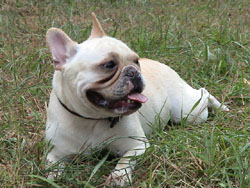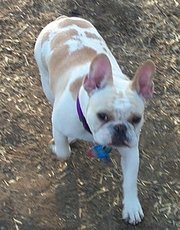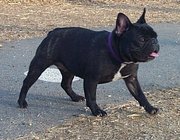French Bulldog
Dogs
French Bulldog
| French Bulldog |

A light-colored French Bulldog
|
| Alternative names |
| Bouledogue Français |
| Country of origin |
|
France |
| Common nicknames |
| Frenchie |
| Classification and breed standards |
|
FCI: |
Group 9 Section 11 #101 |
|
|
AKC: |
Non-sporting |
|
|
ANKC: |
Group 7 (Non-Sporting) |
|
|
CKC: |
Group 6 - Non-Sporting Dogs |
|
|
KC (UK): |
Utility |
|
|
NZKC: |
Non-sporting |
|
|
UKC: |
Companion Breeds |
|
| Not recognized by any major kennel club |
| This breed of dog is
extinct |
| Notes |
| |
 The honey
pied coat is a fairly rare coloring.
The honey
pied coat is a fairly rare coloring.
Appearance
French Bulldogs average 22 to 25 pounds (10 to 12 kg) and are considered
out-of-breed if they are over 28 pounds (13 kg). Their physical appearance is
characterized by naturally occurring 'bat ears' that are pointy and stick
straight up. Their tails are naturally short, not cropped. Otherwise, their body
shape is similar to that of an
English Bulldog.
There are several color variations allowed by the
AKC that are disallowed in Europe, including the cream color. French
Bulldogs have their own variations in the amount of
brindle,
darkness of their coat, and amount of white areas.
Temperament
The French Bulldog is a gentle breed that typically has a happy-go-lucky
attitude. Like many other
companion dog breeds they have high energy and prefer interaction with
humans to interaction with other dogs. They do well around other dogs and small
children, though they should be monitored closely during their initial
encounters; they tend to shy away from teasing or rough play. They tend to not
bark a lot and are of small size; these qualities may make them a good candidate
for apartment living.
Health
European French Bulldogs typically are born naturally, while North American
French Bulldogs are born by
Caesarean section.
 Brindle is a
more common color for the French Bulldog
Brindle is a
more common color for the French Bulldog
Due to the nature of their short windpipe, they tend to have breathing
difficulties, and can easily suffer problems in hot weather as a result. For the
same reason, veterinarians consider them difficult to intubate for surgery.
Otherwise, they are generally considered a healthier breed than the English
Bulldog, with a lower occurrence of problems such as
hip
dysplasia. Like their larger cousin the English Bulldog, French Bulldogs are
prone to gastro-intestinal problems such as gas. The facial wrinkles often trap
dirt, tears, and
mucous, and can become irritated and infected.
Life expectancy is 10 to 12 years.
History
The breed emerged as English
Bulldogs were
bred with
Toy Bulldogs by the artisan community in Paris, after
Toy
Bulldogs were marginalized by British kennel clubs as weakening the English
Bulldog
breed. Toy Bulldogs were popular amongst the artisan and gay communities in
Britain. The breeding of the minuscule Toy Bulldog (averaging 8 pounds (3.5 kg))
and the English Bulldog (which can vary in size, but is usually around 50 pounds
(23 kg)) produced the medium-sized French Bulldog.
Books
- McDonald,Joan. The Book of the Bulldog,
Neptune, NJ:TFH Publications, ISBN 0866220275
- Jenkins, Robert. The Story of the Real Bulldog
Neptune, NJ: TFH Publications,
ISBN 0793804914
Home | Up | Field Spaniel | Fila Brasileiro | Finnish Lapphund | Finnish Spitz | Flat-Coated Retriever | Fox Terrier | Fox Terrier (Smooth) | Fox Terrier (Wire) | Foxhound | Francais Blanc et Noir | French Bulldog
Dogs, made by MultiMedia | Free content and software
This guide is licensed under the GNU
Free Documentation License. It uses material from the Wikipedia.
|




